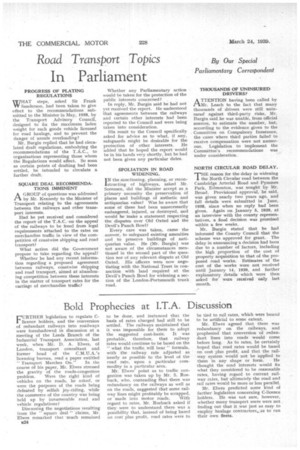Bold Prophecies at I.T.A. Discussion F URTHER legislation to regulate Clicence
Page 50

If you've noticed an error in this article please click here to report it so we can fix it.
holders, and the conversion of redundant railways into roadways were foreshadowed in discussion at a meeting of the Leeds Branch of the Industrial Transport Association, last week, when Mr. D. A. Elwes, of London, transport consultant and former head of the C.M.U.A.'s licensing bureau, read a paper entitled
" Transport Marches On." In the course of his paper, Mr. Elwes stressed the gravity of the roads-congestion problem. Were the right kind of vehicles on the roads, he asked, or were the purposes of the roads being defeated by selfish joy-riding, while the commerce of the country was being held up by innumerable road and vehicle regulations?
Discussing the negotiations resulting from the " square deal " 'claims, Mr. Elwes remarked that much remained
24
to be done, and instanced that the basis of rates charged had still to be settled. The railways maintained that it was impossible for them to adopt the suggested cost-basis. It was probable, therefore, that railway rates would continue to be based on the " what the traffic will bear" formula, with the railway rate adjusted as nearly as possible to the level of the road rate, upon a particular commodity in a particular area, Mr. Elwes' point as to traffic congestion was taken up by Mr. S. Roebuck, who, contending that there was redundancy on the railways as well as on the roads, suggested that some railway lines might profitably be scrapped, or 'made into motor roads. With regard to rates, Mr. Roebuck asked if they were to understand. there was a possibility that, instead of being based on cost plus profit, road rates were to be tied to rail rates, which were bound to be artificial to some extent.
Mr. Elwes agreed that there was redundancy on the railways, and prophesied that conversion of redundant lines into roads would come before long. As to rates, he certainly hoped that road rates would be based on cost plus profit, and that the railway system would not be applied to
them in any shape or form. He thought the road interests would fix what they considered to be reasonable rates, having regard to current railway rates, but ultimately the road and rail rates would be more or less parallel.
Mr. Elwes predicted some kind of further legislation concerning C-licence holders. He was not sure, however, whether many transport users were not finding out that it was just as easy to employ haulage contractors._as to run their own fleets.




















































































